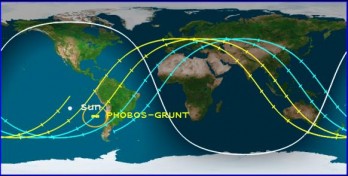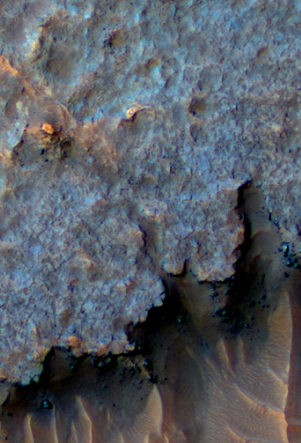Winter on Mars has finally ended, and Opportunity is on the move again.
Winter on Mars has finally ended, and Opportunity is on the move again.
Winter on Mars has finally ended, and Opportunity is on the move again.
Winter on Mars has finally ended, and Opportunity is on the move again.
Mars Reconnaissance Orbiter has found that some dunes on Mars move and change as much as those on Earth.
Curiosity takes a picture of itself on its way to Mars.
A trio of twisters captured on Mars in a single image.
Coiling lava found on Mars.
Mars: dry with only periodic short bursts of wetness.
Though this Science article outlines well the present “consensus” for Mars’s past climate, it also tries to make it sound like the planetary science community had once believed that Mars was once ocean-covered like the Earth and now has abandoned that consensus. To this I say bunk. Though many respected planetary scientists have looked for and found evidence for a past ocean on Mars, this possibility has always been controversial. From my readings most planetary scientists have always believed that Mars has generally been dry, interspersed with short periods when there is flowing liquid water on its surface. Even the advocates of the Martian ocean never proposed an Earthlike ocean, but a somewhat shallow and short-lived phenomenon.
Mysterious cloud spotted on Mars by amateur astronomers.
Liquid water on Mars! Scientists have found more evidence that the streaks on Martian hillsides that darken in warm weather are caused by melting groundwater flowing downhill.
Last summer, the team pointing the HiRISE camera on the NASA Mars Reconnaissance Orbiter (MRO) dropped that bombshell: it had identified 7 confirmed and 12 likely sites that contained hundreds of narrow streaks on steep slopes inside crater walls. During warmer seasons, as temperatures rose as high as 27 degrees Celsius, the streaks darkened, and then faded again. Salts could allow brines to be liquid at these temperatures. Today at the Lunar and Planetary Science Conference in The Woodlands, Texas, the HiRISE team announced that it now has doubled it stash of streaks, with the identification of 15 confirmed and 23 likely sites, all in the mid-latitudes of the Southern Hemisphere.
Additional analysis of the spectrographic data also suggests that water could be the cause of the darkening.
Thank you Barack! Europe, dumped by Obama administration and NASA, has teamed up with Russia to build its ExoMars orbiter and lander.
An artist’s conception of Martian weather. With pictures.
Competition rules! Russia’s space agency has proposed a space exploration plan through 2030, including missions to the Moon and Mars, in an effort to catch up with the U.S.
In a February 29 letter to NASA, House appropriators have challenged the Obama administration’s decision to shut down the agency’s Mars planetary program.
When a solar storm slammed into both the Earth and Mars in January 2008, scientists were able to directly measure the importance of the Earth’s magnetic field in protecting our atmosphere from oxygen loss.
They found that while the pressure of the solar wind increased at each planet by similar amounts, the increase in the rate of loss of martian oxygen was ten times that of Earth’s increase. Such a difference would have a dramatic impact over billions of years, leading to large losses of the martian atmosphere, perhaps explaining or at least contributing to its current tenuous state. The result proves the efficacy of Earth’s magnetic field in deflecting the solar wind and protecting our atmosphere.
Scientists have found new evidence for recent earthquakes on Mars.
The Martian meteorite that was recovered in Morocco in July is now thought to contain pockets of trapped Martian atmosphere.
Or at least, the geology says the meteorite should have these pockets. The actual analysis has not yet happened.
All NASA funding for ESA’s unmanned ExoMars mission appears to have been cut by the Obama administration.
A public announcement by Nasa of its withdrawal from the ExoMars programme, as it is known in Europe, will probably come once President Obama’s 2013 Federal Budget Request is submitted. This request, expected in the coming days, will give the US space agency a much clearer view of how much money it has to implement its various projects. “The Americans have indicated that the possibility of them participating is now low – very low. It’s highly unlikely,” said Alvaro Gimenez, Esa’s director of science.
Though this story doesn’t confirm the earlier rumors that the Obama administration was going to eliminate the entire NASA planetary program, it sure lends those rumors further weight. However, the new budget should be released any day now, when we will finally find out.
Mars Express has found more evidence that Mars once had oceans.
Two oceans have been proposed: 4 billion years ago, when warmer conditions prevailed, and also 3 billion years ago when subsurface ice melted following a large impact, creating outflow channels that drained the water into areas of low elevation.
“MARSIS penetrates deep into the ground, revealing the first 60–80 metres of the planet’s subsurface,” says Wlodek Kofman, leader of the radar team at IPAG. “Throughout all of this depth, we see the evidence for sedimentary material and ice.” The sediments revealed by MARSIS are areas of low radar reflectivity. Such sediments are typically low-density granular materials that have been eroded away by water and carried to their final destination.
This later ocean would however have been temporary. Within a million years or less, Dr Mouginot estimates, the water would have either frozen back in place and been preserved underground again, or turned into vapour and lifted gradually into the atmosphere. “I don’t think it could have stayed as an ocean long enough for life to form.”
If at first you don’t succeed: Russia today announced plans to launch Phobos-Grunt 2 in 2018.
A meteorite that fell to Earth last July in Morocco has proven to be a rare chunk of Mars.

Updated and bumped. An updated prediction from Aerospace now calls for Phobos-Grunt to come down sometime between 9 and 3 pm (Eastern). This puts the U.S. now out of danger, though Europe, South America, Africa, Australia, and the southern half of Asia all remain in the spacecraft’s path.
Watch your heads! Phobos-Grunt is due to crash to Earth anytime in the next ten hours. And unfortunately, this new prediction has it flying over both North America and much of Europe and Africa during that time period.
Opportunity has settled into its winter haven.
NASA’s Mars Exploration Rover Opportunity will spend the next few months during the coldest part of Martian winter at Greeley Haven, an outcrop of rock on Mars recently named informally to honor Ronald Greeley, Arizona State University Regents’ professor of planetary geology, who died October 27, 2011.
I met and interviewed Greeley a number of times in writing articles for magazines like Sky & Telescope and Astronomy. For years he was a central figure in the field of planetary geology, and his life effort is one of the prime reasons the United States has dominated this field for most of the past half century, with a fleet of planetary missions presently at Mercury, Mars, Jupiter, Saturn, and Pluto, with many more to come.
The article notes that the International Astronomical Union (IAU) has the job of naming objects in space, and could take years to honor Greeley. I say that if these scientists, the true explorers of Mars, want to name something for him, then they should go ahead, and future generations should honor that choice, regardless of what the IAU says.

The uncertainty of science: In this week’s release of images from Mars Reconnaissance Orbiter, the science team posted the image on the right and asked, “What is this stuff?”
Here’s a hypothetical geologic history that might explain this scene: layered sediments were deposited by water or airfall (including volcanic pyroclastics). A crudely polygonal patterned ground was created by stresses in the sediments, and groundwater followed the fractures and deposited minerals that cemented the sediments. This was followed by perhaps billions of years of erosion by the wind, leaving the cemented fractures as high-standing ridges.
Of course, this story is almost certainly incomplete if not totally wrong.
Click here to see the close-up subimage from which I cropped the image on the right.
Scientists have found microbes inside a lava tube that can thrive in the freezing cold and low oxygen environment of Mars.
In a laboratory setting at room temperature and with normal oxygen levels, the scientists demonstrated that the microbes can consume organic material (sugar). But when the researchers removed the organic material, reduced the temperature to near-freezing, and lowered the oxygen levels, the microbes began to use the iron within olivine – a common silicate material found in volcanic rocks on Earth and on Mars – as its energy source.
Mars Reconnaissance Orbiter today released an image of a really spectacular transform fault on Mars, a spot where the ground cracked and two sections moved sideways to each other. In this case, the sideways movement was about 300 feet. The image is posted below the fold.
Compare that with the Japanese magnitude 9 earthquake on March 11, which only shifted the seabed sideways 165 feet while raising it 33 feet. The quake that moved these two pieces of Martian bedrock sideways must have been quite a ride.
» Read more